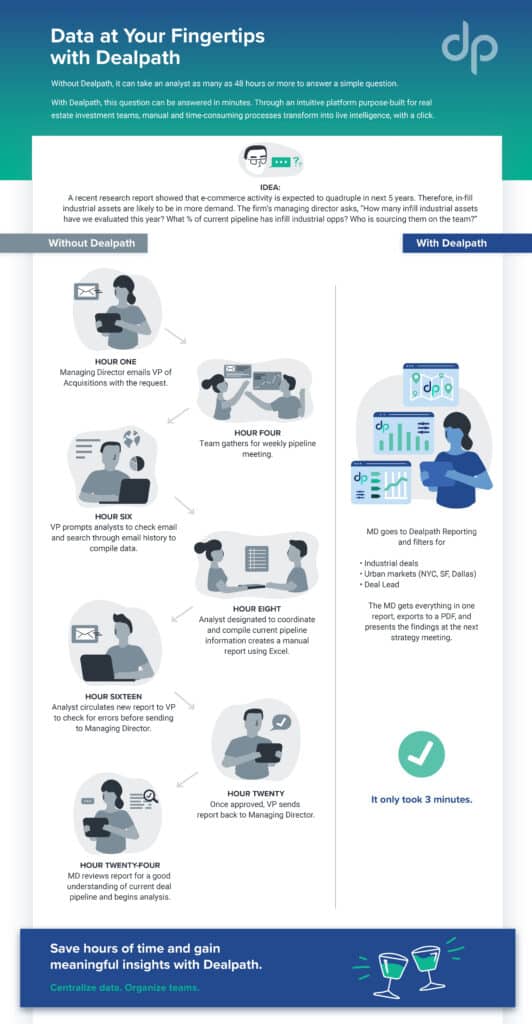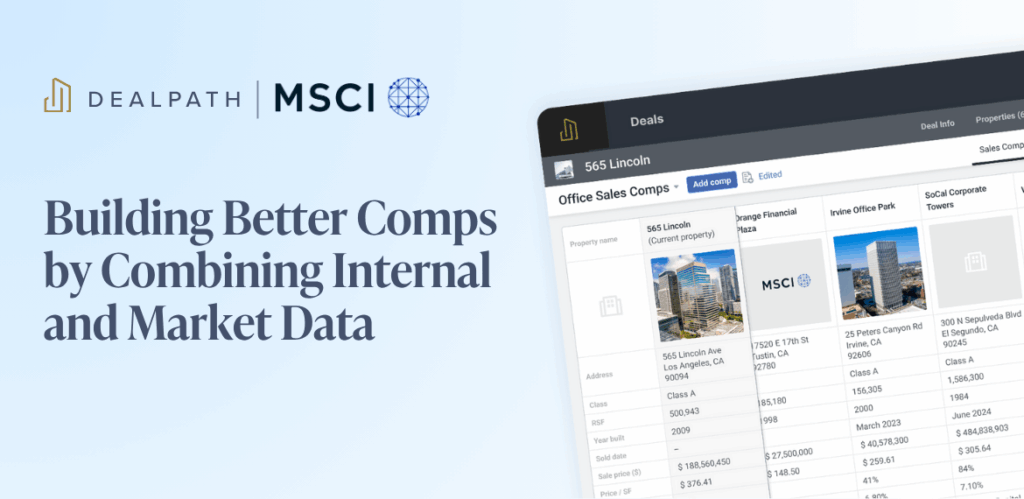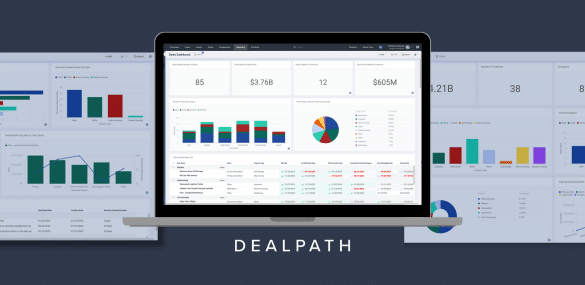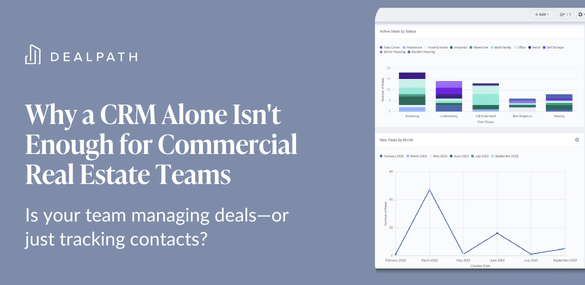This blog post was last updated on Wednesday, April 13th.
Even as the pandemic’s effects linger, IBISWorld’s recent report affirms that the commercial real estate space shows no signs of slowing, with 3.8% year-over-year growth projected and a $1 trillion valuation. To grow a competitive portfolio, real estate investment managers must source every relevant deal, analyze potential returns, and execute on the best opportunities. Unfortunately, technology, workflow and communication-related complications often leave deals hanging in the balance. When this happens, you run the risk of losing momentum–or even the entire deal. Honing in on real estate pipeline management can help you to eliminate bottlenecks and reduce friction, ensuring that deals flow efficiently and that your firm generates the highest returns.
Read on to learn about 8 real estate pipeline management bottlenecks you can eliminate with the right technology.
Jump to:
- The Goal of Real Estate Pipeline Management: Visibility, Deal Flow & Scale
- 8 Bottlenecks You Can Eliminate to Improve Real Estate Pipeline Management
- Managing Critical Deal Data in a Local Drive or Shared Drive Instead of Deal Pipeline Software
- Lack of Real-Time Visibility Into Real Estate Pipeline
- Unstandardized Real Estate Data Creates Manual Pipeline Management Work
- Working Across Disparate Systems Like Email, Project Management Tools & File Sharing Services
- Unstandardized (or Ad-Hoc) Deal Review & Execution Processes
- Lack of Automated Real Estate Pipeline Management Workflows
- Manual Reporting
- Manual Deal Sourcing & Data Entry
- Streamline Real Estate Pipeline Management
The Goal of Real Estate Pipeline Management: Visibility, Deal Flow & Scale
In simple terms, the most effective way for investors to build the highest-performing portfolio is to source every deal relevant to their investment strategy and goals, screen the financials based on institutional data, and pursue only the most profitable opportunities. But when surfacing reliable deal comps takes hours and due diligence lasts over a month, decision makers are slow to approve next steps, or deal teams are bogged down with manual reporting, deal flow inevitably suffers. Pipeline management bottlenecks like this might seem like minor issues, but for growth-driven firms, they can be an obstacle to scale.
Optimizing real estate pipeline management doesn’t necessarily mean overhauling how your firm invests. Instead, it’s an opportunity to make minor changes to your existing process and implement the right investment software, like a deal management platform. In turn, deal teams work the highest level of efficiency and generate the highest returns.
For many real estate investment firms, it can take hours to aggregate pipeline data from multiple sources (Email, Excel, Salesforce, Teams) and compile into a single report. The infographic below compares accessing pipeline data that is stored and managed in legacy applications to accessing the same data that is managed in a deal management platform (spoiler alert: it takes 3 minutes).

8 Bottlenecks You Can Eliminate to Improve Real Estate Pipeline Management
As your firm scales, reevaluating how your technology empowers holistic, efficient investment is essential. These are the most common bottlenecks that investment management firms can eliminate by upgrading to real estate deal pipeline management technology.
1. Managing Critical Deal Data in a Local Drive or Shared Drive Instead of Deal Pipeline Software
Data should be the driving force behind your real estate pipeline management strategy, but leveraging it should never require substantial effort. Real estate investment management teams that store data either on a local network drive or shared drive often suffer two significant consequences.
First, others within the company may access potentially inaccurate data. As assets move throughout their lifecycles, property and asset management teams generally update this data for their own use. But when data is siloed across various teams, there is no easy way to find a reliable answer. Investors aren’t updating data in real time; they’re updating one spreadsheet, which other parties may not be aware of, or even have access to. In turn, teams run the risk of making multi-million dollar decisions based on inaccurate data.
Second, aggregating and using proprietary, third-party and paid data to evaluate a deal can become a hurdle in and of itself. Even after tracking it down, investors may still lack the full confidence required to act based on the data.
Employing a cloud-based real estate deal pipeline management system ensures that everyone in your team has streamlined access to real-time data. Your team can make updates on the fly, whether they’re traveling for work, working from home, on vacation, or meeting an investor for coffee. Because your entire team has access to that platform, they can independently find and use that data.
2. Lack of Real-Time Visibility Into Real Estate Pipeline
To prioritize deal work and report knowledgeably to senior leadership, it’s imperative for investment managers to track pipeline progress. If you don’t know which deals are approaching closing and the next steps, how can you plan accordingly? Unfortunately, spreadsheet trackers make this more challenging than it should be–often detracting from team productivity.
Updating spreadsheets requires significant time and bandwidth, which delays crucial updates for executives. For a true indication of where deals stand, leadership must first check in with multiple team members, which becomes increasingly unscalable.
Using a deal pipeline management software platform ensures that all updates are reflected in real time, rather than incrementally. Because investment managers can easily enter updates as they occur, managers and executives can stay apprised of every update along the way.
3. Unstandardized Real Estate Data Creates Manual Pipeline Management Work
Making deal data accessible is paramount, but standardization makes that data easier to work with. As you gather information to review investment opportunities, you’re amassing a treasure trove of data that holds tremendous value when it comes to market trends and benchmarks for future investments. Without standardized data at the ready, though, comparing metrics like you would “apples to apples” requires significant upfront work.
By taking a more strategic approach to real estate pipeline management with deal management software, you can source deals with standardized data. This minor change can streamline deal data analyses, enabling your firm to review even more deals at a faster pace.
4. Working Across Disparate Systems Like Email, Project Management Tools & File Sharing Services
In order to best manage your firm’s real estate pipeline, your team must have the resources required to be productive. However, the traditional workflow model of cobbling together tools like Excel, email, project management software, cloud-based file storage services and countless other systems can limit productivity. Even with clearly defined steps at every juncture, shifting from one platform to the next requires a change in mindset, and often, duplicative data entry.
To streamline deal flow, find tools that enable your team to accomplish more with less. Rather than relying on different systems for various functions, adopt technologies that fulfill multiple needs. For example, Dealpath tracks real-time investment data, while also allowing users to keep a running commentary on all deals and information. Centralizing these functions within one tool ensures that data, remaining tasks, and other important pieces are in sync.
5. Unstandardized (or Ad-Hoc) Deal Review & Execution Processes
Working in a systematic and predictable fashion is the only way to efficiently scale real estate pipeline management processes on your firm’s path to growth. Nonetheless, a lack of clarity around the steps involved in this comprehensive process poses challenges.
What should analysts review when first examining a deal? Which deals require a zoning analysis, and when? Are there specific permits required to close on ground-up industrial development deals in Pennsylvania? Operating without documented, clear processes can create risk for deals that require attention to detail.
Rather than leaving things to chance, rely on real estate pipeline management technology that tracks these tasks in the form of a checklist. Because generalized checklists may omit deal specifics, be sure to create conditional deal checklists that include specific steps based on certain details. This not only provides clarity for existing team members, but also expedites onboarding.
6. Lack of Automated Real Estate Pipeline Management Workflows
The most important real estate pipeline management and deal decisions should always fall to investors with trained eyes and intuition. But, that doesn’t mean deal teams should accomplish everything manually. As you work to identify bottlenecks in how you manage your real estate pipeline, consider where automating select processes may behoove you.
The goal of automation is never to bypass important decisions, but to arrive at these touchpoints with reduced friction. For example, if deals are normally routed to a VP after gathering data, then automated workflows can dynamically push those deals to their inboxes based on defined stage rules. By implementing automation, you can streamline deal flow along the real estate pipeline process, while maintaining your time-tested investment criteria.
7. Manual Reporting
Routine deal pipeline reports keep executives informed about progress and project targets, while also aligning teams on priorities. Unfortunately, when crucial deal information is siloed throughout various systems, creating these reports is rarely turnkey.
To create a pipeline report, analysts must gather the most up-to-date information across the acquisitions team, then cross-reference the real estate tracker spreadsheet. Reports can provide tremendous value, but the number of sources and steps makes this challenging and, often, unscalable. When urgent reports become a priority, it’s not uncommon for analysts to leave pressing deal execution by the wayside.
Add speed and precision to your reporting by utilizing a tool that does this work for you. Many real estate pipeline management platforms dynamically create pipeline reports in just a few clicks. In fact, Dealpath allows users to create highly filtered reports based on factors like location, deal stage, and much more. By utilizing a tool that produces reliable, accurate reports in seconds, your team can deliver relevant information on a consistent basis, without ignoring other pressing items on their to-do lists.
8. Manual Deal Sourcing & Data Entry
As your firm reviews more deals in the market, you’re choosing the best deals from a wider pool–but without intuitive technology driving your process, these options come at the expense of your team’s time. Thanks to advances in proptech, manual data entry is almost entirely avoidable.
Instead of relying on analysts to input data, which leaves room for error, adopt a solution that minimizes manual data entry. Deal management solutions like Dealpath enable you to source deals simply by uploading data via a spreadsheet, Outlook, or in other intuitive ways. Removing this overwhelming burden from their plates means your team can focus on reviewing more deals.
Streamline Real Estate Pipeline Management
There’s a reason why more real estate investment firms like Blackstone, Oxford Properties, Bridge Investment Group, and Principal rely on deal pipeline management software. With all deals and data in a single platform, teams and stakeholders can collaborate seamlessly, get real-time visibility into accurate information, and deploy capital strategically.
Transitioning to new software should never mean foregoing your existing processes and workflows. Download this free white paper for a deeper look at how you can leverage industry-specific real estate pipeline deal management software to expedite deal flow and make your data your competitive advantage.
Download White Paper


